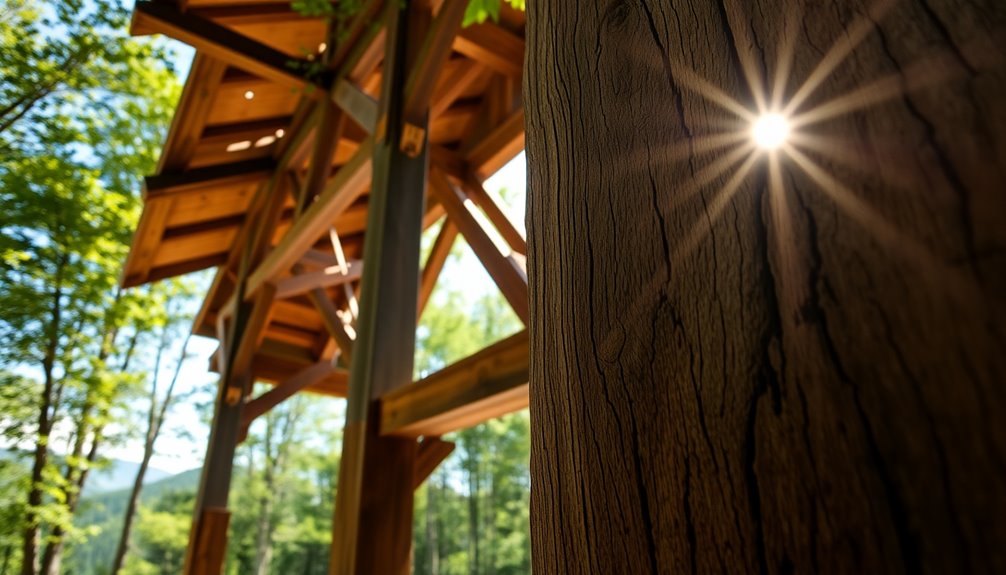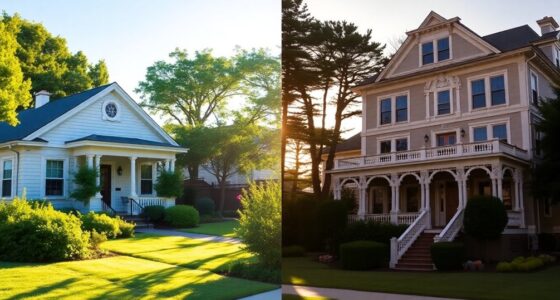Timber frames can last between 50 to 100 years if you maintain them well, making them a durable choice for construction. The longevity largely depends on factors like wood species, moisture levels, and your maintenance routine. Using harder woods such as Douglas Fir or Western Red Cedar can improve durability. Regular inspections and prompt repairs prevent damage from moisture and pests. You'll want to clean and treat the timber every few years to keep it protected from the elements. Stick around, and you'll uncover more tips on enhancing your timber frame's lifespan and overall durability.
Key Takeaways
- Timber frames can last between 50 to 100 years with proper maintenance and care.
- The choice of wood species, such as Douglas Fir, significantly affects durability and resistance to decay.
- Regular inspections and timely repairs are essential to prevent moisture damage and pest infestations.
- Effective maintenance practices, including cleaning and protective coatings, enhance the lifespan of timber frames.
- Timber frames promote sustainability, being renewable and capable of efficient insulation, further supporting their long-term viability.
Historical Significance of Timber Frames
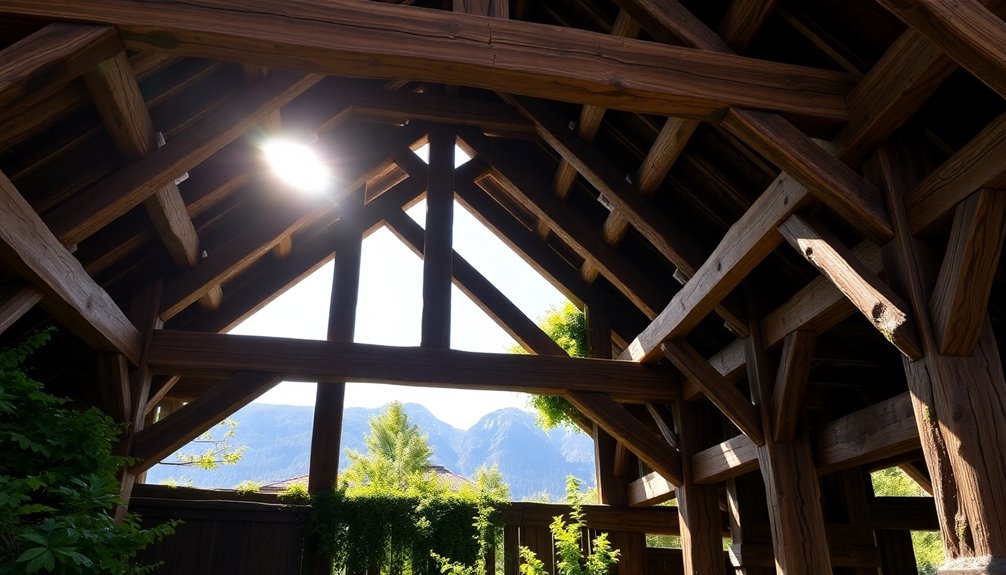
Timber frames hold an essential place in architectural history, as they've been used for centuries across various cultures.
Timber frame construction began in ancient India around 200 B.C. and later spread to Europe and America. The historical significance of this method lies in its adaptability; you'll find timber frames in barns, churches, and homes.
The durability of timber contributes to the structural integrity of these buildings, allowing them to endure for generations. Notable examples, like Japan's Hōryū-ji temple and English barns, showcase the long lifespan of a timber, often exceeding 400 years.
This resilience highlights why timber framing remains a crucial architectural practice, reflecting both its rich heritage and enduring relevance in today's construction landscape.
Construction Fundamentals
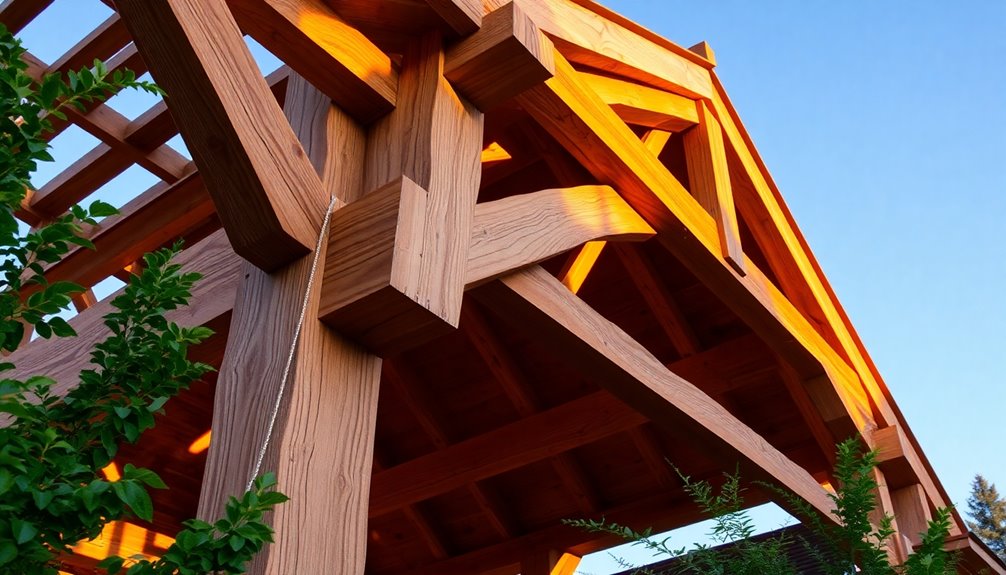
When constructing a timber frame building, understanding the fundamental techniques is essential for ensuring its longevity and stability.
The use of large wooden beams and traditional joinery, like mortise and tenon joints, provides strength and durability. A steeper roof pitch and large overhangs help shed moisture, protecting the timber from weather damage.
Choosing the right wood species is vital, as varying levels of decay resistance directly impact your building's durability.
Additionally, incorporating structural insulated panels (SIPs) enhances insulation without compromising the aesthetic appeal of traditional timber framing.
Factors Influencing Lifespan
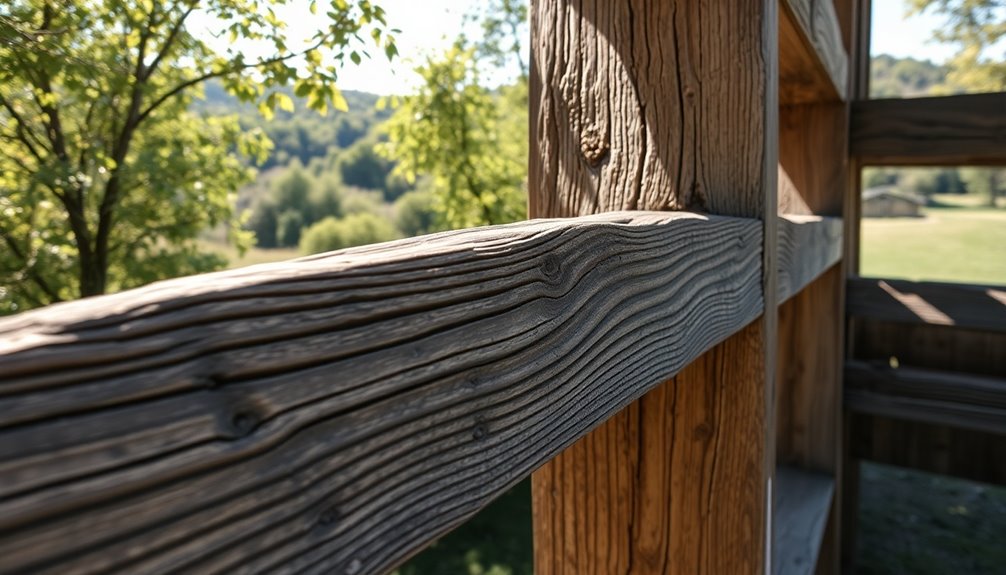
Several factors influence the lifespan of a timber frame building, starting with the type of wood used. Harder wood species like Douglas Fir and Western Red Cedar naturally resist decay and insects, enhancing durability. Moisture content is also critical; high levels can lead to fungal decay.
Here's a quick overview of key factors:
| Factor | Impact on Lifespan |
|---|---|
| Wood Species | Harder species last longer |
| Moisture Content | High moisture can cause decay |
| Regular Maintenance | Timely repairs prevent damage |
| Insect Protection | Treatments help protect against pests |
| Environmental Exposure | Conditions affect preservation |
Regular maintenance and treatment with preservatives can noticeably extend your timber frame's life, helping you protect against insects and moisture-related issues.
Types of Timber Used
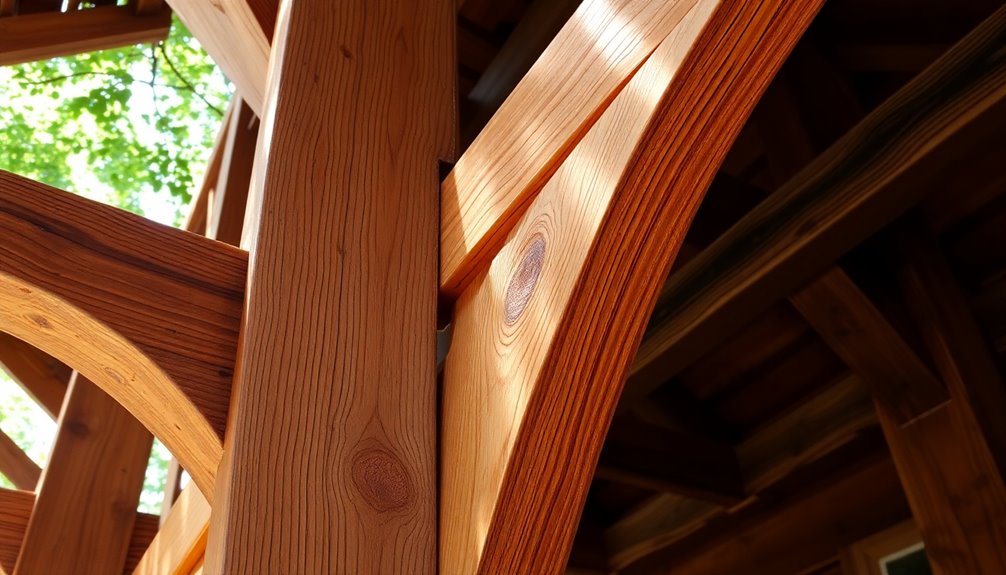
Choosing the right type of wood is vital for a timber frame's longevity and performance.
Western Red Cedar stands out for its natural resistance to decay and insect infestations, making it perfect for outdoor projects.
Douglas Fir, known for its strength, is ideal for heavy-duty applications like beams.
If you value both beauty and durability, Redwood offers inherent decay resistance, suitable for both indoor and outdoor uses.
Cypress boasts natural insect-repelling properties and excels in moisture-prone environments.
Finally, Ipe is an exceptionally hard and dense timber, perfect for high-end applications where durable wood and longevity are essential.
Selecting the right timber not only enhances your structure's performance but also showcases its natural beauty.
Maintenance Best Practices
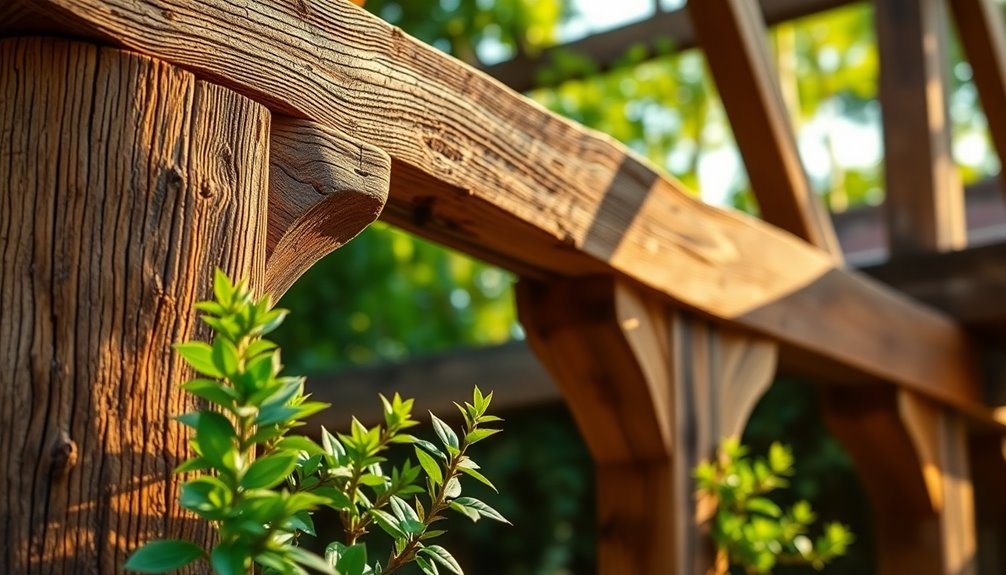
To guarantee your timber frame lasts for years, regular maintenance is key. By staying proactive, you can protect your investment and secure its longevity. Here are some best practices to follow:
- Inspect annually for moisture damage and pest infestations.
- Maintain indoor humidity levels between 30-50% to prevent wood decay.
- Clean and seal exposed timber surfaces regularly to shield against UV damage and moisture.
Addressing leaks or moisture issues promptly is essential, as untreated problems can lead to rot and structural compromise. Implement proper ventilation and consider using dehumidifiers to control humidity levels. Additionally, consistent maintenance practices can help prevent costly repairs and replacements.
Common Challenges Faced
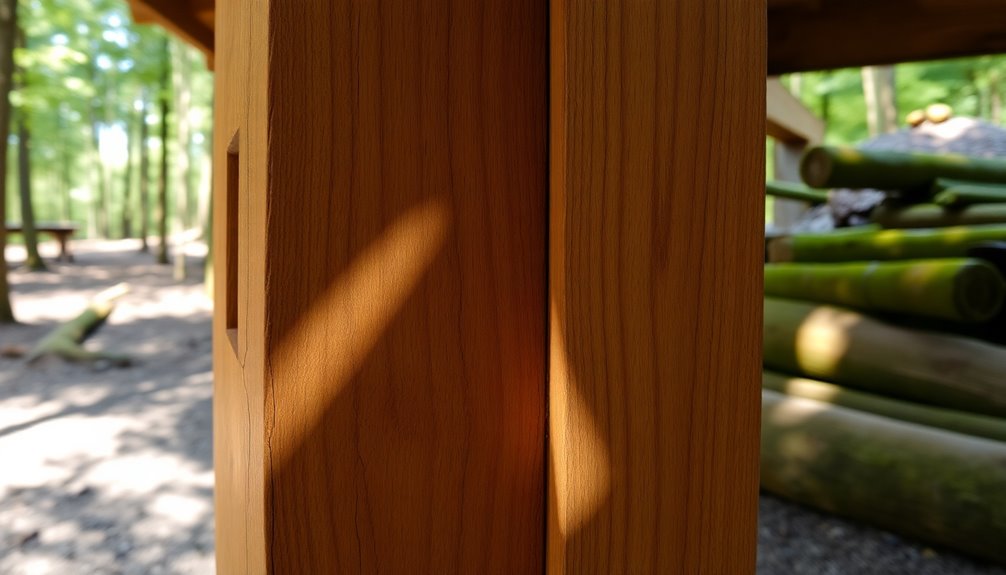
While timber frames offer a beautiful and sustainable building option, they come with their own set of challenges that can threaten their longevity.
Moisture-related issues are a primary concern, as improper ventilation and humidity control can lead to wood decay.
Pest infestations, like termites and wood-boring insects, also pose significant risks, making regular inspections and preventive treatments essential.
Additionally, weather exposure—whether it's prolonged sunlight or rain—can deteriorate wood surfaces and joints, requiring consistent maintenance to maintain structural integrity.
Seasonal changes create further stress, causing wood to expand and contract, which may lead to cracking if not properly designed.
Addressing these challenges is vital to extending the lifespan of your timber frame construction.
Preservation Strategies
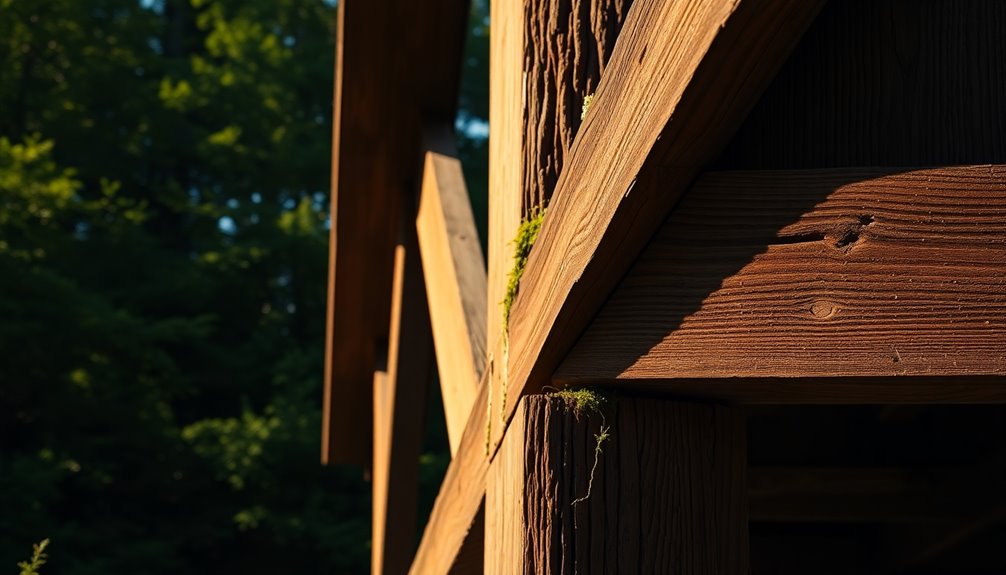
To keep your timber frame in top shape, routine cleaning and sealing are essential.
These practices protect the wood from moisture and decay, ensuring it lasts longer.
Additionally, applying protective coatings can shield your structure from UV damage, maintaining its integrity over time.
Routine Cleaning Practices
Maintaining the longevity of your timber frame requires regular cleaning to keep it free from debris, dirt, and organic matter that can trap moisture and lead to decay.
Implementing routine cleaning practices can greatly enhance your timber's durability. Here are some key strategies:
- Inspect for early signs of damage, such as pest infestations or wood decay.
- Use mild, non-abrasive cleaning solutions to avoid harming the wood's finish.
- Ascertain proper drainage by keeping gutters and downspouts clear to prevent moisture accumulation.
Protective Coatings Application
Routine cleaning practices create a strong foundation for the longevity of your timber frame, but applying protective coatings takes preservation a step further.
These coatings, like sealants and stains, should be reapplied every 3 to 5 years to shield your wood from moisture and UV damage. By creating a barrier, high-quality protective coatings prevent wood decay and insect infestations, greatly enhancing the durability of your structure.
Always apply these coatings in dry conditions, ensuring the wood moisture content is below 20% for proper adhesion. Remember to clean the surface regularly to avoid dirt buildup, which can lead to premature coating failure.
Opt for eco-friendly, breathable coatings to manage moisture while protecting against weathering, preserving your timber frame's integrity.
Renovation Techniques
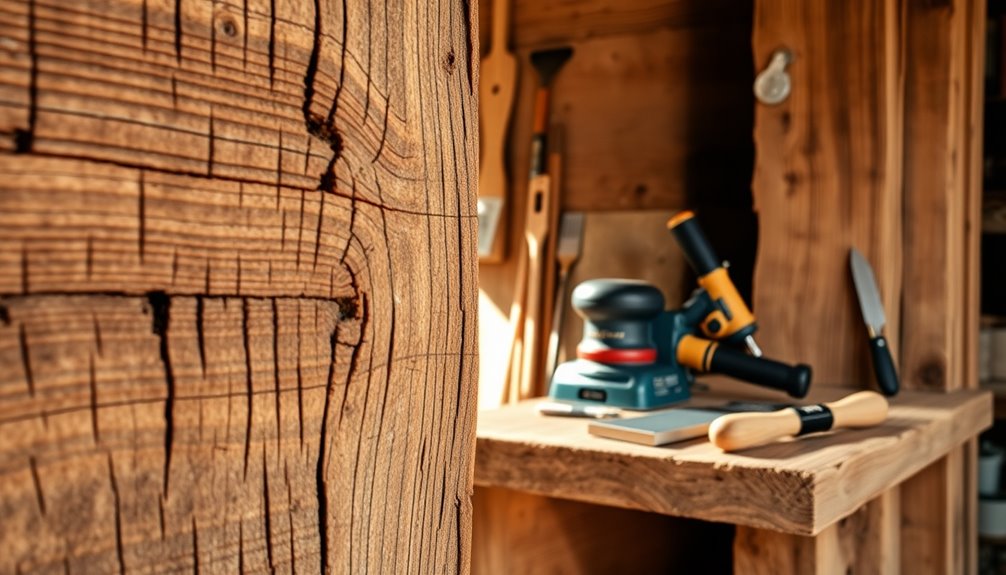
Renovating a timber frame home requires careful consideration to preserve its unique character and craftsmanship.
You'll want to focus on effective renovation techniques that maintain historical integrity while enhancing functionality.
Here are some key points to keep in mind:
- Use traditional materials to respect the original design.
- Address any moisture issues through proper ventilation and management.
- Incorporate sustainable practices, like sourcing reclaimed timber for repairs.
Environmental Impact and Sustainability
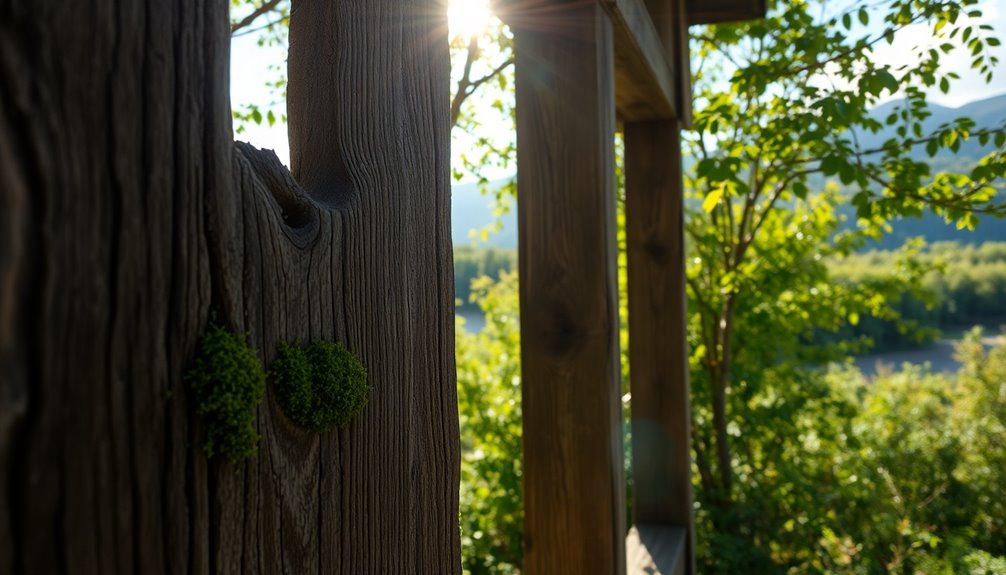
Timber frame homes not only offer historical charm but also present a significant opportunity for environmentally conscious living. By choosing timber as your primary building material, you embrace sustainability and reduce your carbon footprint. Sustainably sourced timber sequesters carbon, while energy-efficient designs lower heating and cooling costs. Additionally, the use of wood as a renewable resource helps minimize reliance on fossil fuels, further contributing to environmental sustainability.
| Aspect | Benefit | Impact |
|---|---|---|
| Building Materials | Naturally renewable resource | Lower environmental impact |
| Energy Efficiency | Thick walls and insulation | Reduced energy costs |
| Sustainability | Supports ecosystem health | Promotes reforestation |
| Modern Technologies | Solar panels and geothermal systems | Enhanced carbon reduction |
Frequently Asked Questions
How Long Will a Timber Frame Last?
When you ask how long a timber frame will last, it really depends on various factors.
If you use durable wood species and follow proper construction techniques, your timber frame can last over 100 years.
Regular maintenance, like inspections and treatments for moisture and pests, is crucial to prevent decay.
Environmental conditions also play a role, so it's important to manage moisture effectively to guarantee your timber frame remains strong and intact for years.
How Long Can Timber Frame Span?
When you consider how long a timber frame can span, it typically ranges from 20 to 50 feet, depending on the design and materials used.
If you opt for engineered wood products like laminated veneer lumber (LVL), you could achieve spans of 60 feet or more.
Stronger wood species, such as Douglas Fir or Glulam, provide even greater support, allowing for open floor plans without internal load-bearing walls while adhering to building codes.
What Is the Lifespan of Structural Timber?
The lifespan of structural timber varies greatly depending on factors like wood species and maintenance.
If you choose durable types, like Western Red Cedar or Douglas Fir, and keep up with proper care, you can expect them to last over 50 years.
What Is the Life Expectancy of a Wood Frame Building?
So, you think your wood frame building's gonna outlast the pyramids? Well, it might! If you've chosen quality materials and you're not letting Mother Nature wreak havoc, you could be looking at 50 to 100 years—or even longer!
Just remember to keep an eye on moisture and pesky pests. With regular TLC, your humble abode could stand tall for centuries, joining the ranks of ancient barns and timeless timber marvels!
Conclusion
In the grand tapestry of architecture, timber frames stand as resilient threads, weaving stories through time. By understanding their durability and caring for them with tender hands, you can guarantee these structures remain strong and vibrant, like ancient trees weathering the seasons. Embrace the beauty of timber, nurture it, and watch as it transforms your space into a living symbol of nature and craftsmanship. Together, you and your timber frame can dance gracefully through the years.
